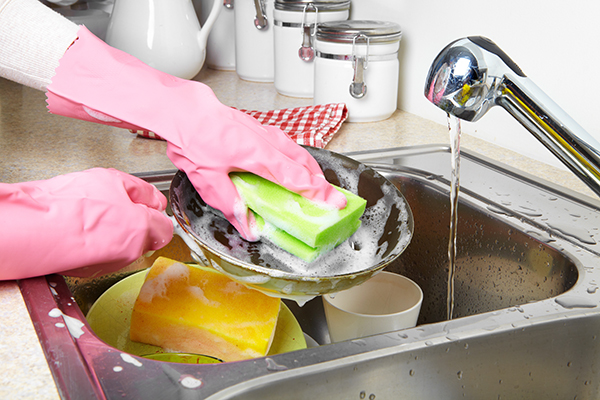Cleaning Up Biological Incidents is No Fun, but Preparation is Key to Protecting Everyone Involved
As I was sitting down to write the second blog for this month, I had an entirely different topic in mind, but then I received a call asking about policies and procedures for cleaning up vomit and diarrhea incidents in foodservice operations. So, much like many of your days, this blog took a 180-degree turn!
Clean-up of vomiting and diarrheal events is certainly not something that many of us think about, nor something that we particularly want to think about. However, this really is the time of year when incidents like this are more likely to happen. When it happens, we must be prepared and not scrambling for information on how to best approach the situation. The food code (section 2-501.11) notes each food establishment shall have a written procedure spelled out on how to deal with such incidents to help employees minimize the spread of contamination and limit the exposure to employees, consumers, food, and surfaces.
Often when this does occur, the pathogen we are most concerned about is Norovirus, which is the leading cause of foodborne outbreaks in the U.S., accounting for more than 50% of all gastrointestinal outbreaks. If not cleaned up appropriately not only are the employees tasked with the clean-up in danger of becoming ill, studies have also shown that Norovirus can survive up to five days at room temperature.
Effectively cleaning up such an incident is much different than our normal routine cleaning procedures. One important thing to do before the incident occurs is to put together the supplies you would need to clean-up the incident and keep your employees safe while doing so. Timely clean-up is imperative to containing the virus. While there are commercial biohazard clean-up kits on the market, they are not always the best option for everyone because you may have many of these items already available in your operation, which negates the need to buy a special kit – simply assemble everything and keep in a place where you employees have ready access to it. At the bare minimum, be sure your kit has the following:
- Personal protective equipment:
- Disposable gloves
- Disposable shoe covers
- Disposable gown
- Disposable face mask
- Disposable towels and cloths
- Pair of goggles
- Absorbent powder (such as kitty litter)
Effectively cleaning up a biological incident is much different than our normal cleaning routine…and effective preparation will keep your employees and customers as safe as possible.
Once an incident happens, make sure the employee who will handle the situation instructs all other employees and customers to vacate the area. It is important to recognize that Norovirus could spread as far as 25 feet away from what you see, so be sure to block off the area and clean and disinfect appropriately.
Be sure any employee who is handling the situation is wears the personal protective equipment outlined above and wears it properly. Next, prepare your disinfectant. Unless you are using a commercial product that notes it is effective for Norovirus, you will need to make your own bleach solution. The CDC notes that you should use a chlorine bleach solution with a concentration of 1,000 to 5,000 PPM. This means that for each gallon of water, you should use 5 to 25 tablespoons of household bleach This assumes your bleach has a concentration of 5% to 8% sodium hypochlorite. If not, check your manufacturers website for the correct concentration.
Use your absorbent powder and/or paper towels to clean-up the materials and liquid. Be sure to place the used materials into a garbage bag.
Spray the area impacted with the bleach solution. Some sources recommend laying own clean paper towels over the area and soaking with the bleach solution. The important part is to make sure the area stays wet with the solution for a minimum of five minutes. Then, clean-up the bleach solution (and paper towels, if you used them) and place into the garage bag.
At this point, it is safe to remove your disposable personal protective equipment and place in the garbage bag, then seal the bag and place it in the trash. After washing your hands and face thoroughly, be sure to rinse any of the areas impacted by the incident with hot soapy water. If you are dealing with a food contact surface, it isn’t a bad idea to use your standard sanitizing solution to re-sanitize the area and let air dry.
After the incident, be sure to also sanitize any high touch areas. Being cautious and thorough is key to protecting yourself, your employees, and your customers. Risk Nothing.
READ MORE POSTS
Properly Cleaning and Sanitizing: The Right Chemical Mix to Maintain Ultimate Effectiveness
A few weeks ago, my family and I had the pleasure of setting sail on a cruise vacation. It is truly one of the only ways that I find that I am able to unplug from work and relax for a small spell. However, as I walked around the ship in our post-COVID world, I couldn’t help but admire all the extra cleaning steps the staff were undertaking to keep us all as safe as possible while in the middle of the ocean with 3,000 other vacationers. All of this cleaning and sanitizing had me thinking about how we each clean and sanitize our own operations and which chemicals we chose to use.
Proper Cooking Temperature: A Basic Food Safety Measure
Each summer, we see an increase in the incidence of foodborne illnesses. Perhaps this is because of the warmer temperatures making temperature control for Time/Temperature Control for Safety (TCS) food more difficult or perhaps it is the increased amount of people who are barbequing this time of year – it is National Picnic Month, after all!
Changing Climate: The Unseen Impact on Food Safety
In June, I was asked to participate in the Allinfoodz podcast, put on by a colleague, Dr. Amit Sharma, at Penn State University. One of the points Dr. Sharma wanted to discuss was the impact of climate change on food safety, which is something I was certainly aware of, but not something I had done much research on. However, when preparing for the interview and podcast, it was interesting to learn more about the relationship between the two.
Thawing Food with Food Safety in Mind
There comes a time in almost every foodservice operation where you must thaw food. Yes, I know there are those operations who have moved to fresh products only and don’t have a freezer in-house, but I am willing to bet that is more the exception than the norm. I am almost sure that anyone reading this blog who works in a foodservice operation can regurgitate what methods are acceptable to thaw food per the FDA Model Food Code. In case you don’t recall, I will discuss them briefly, but I wanted to spend some time covering these requirements a bit more in-depth – so you not only know WHAT to do, but the WHY we do it that way.










